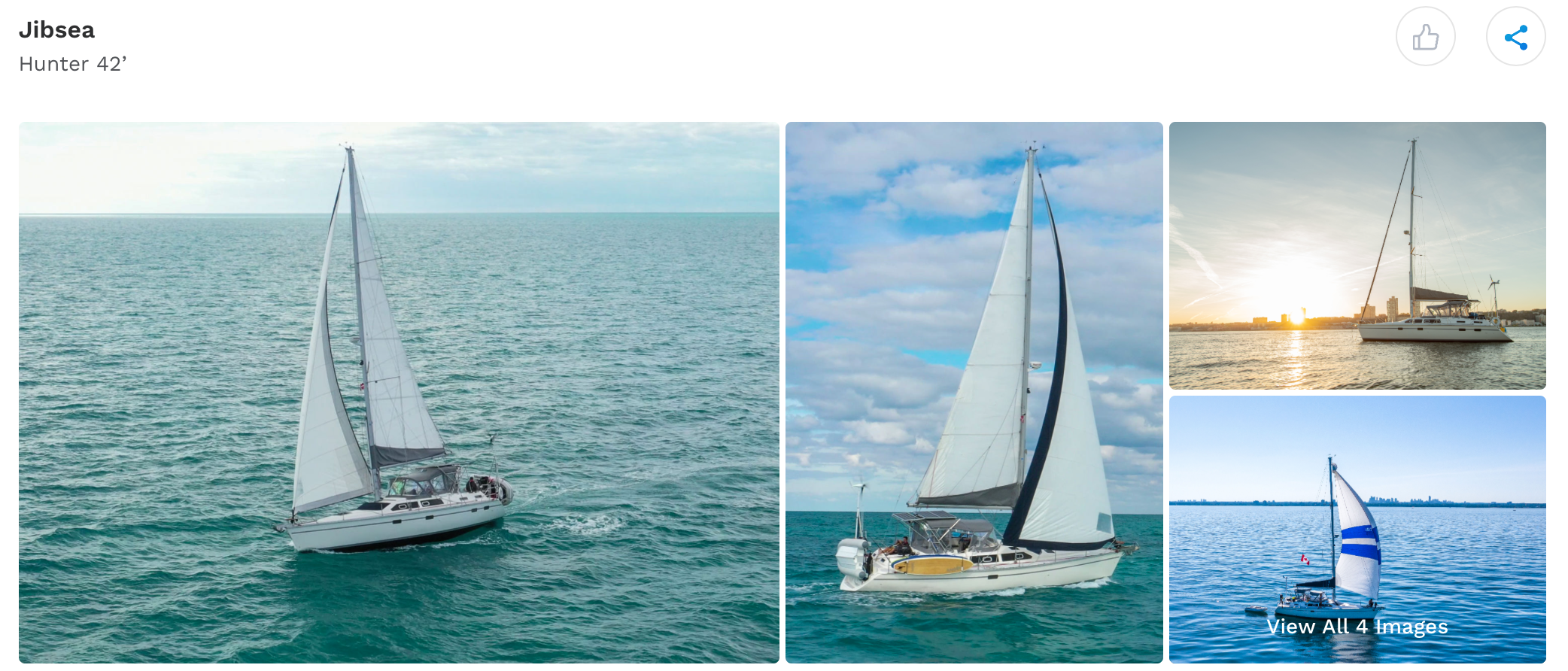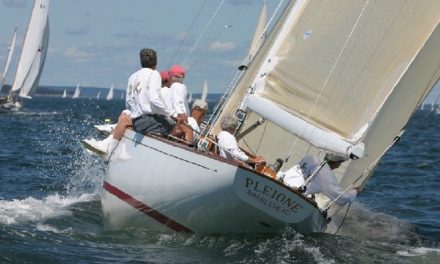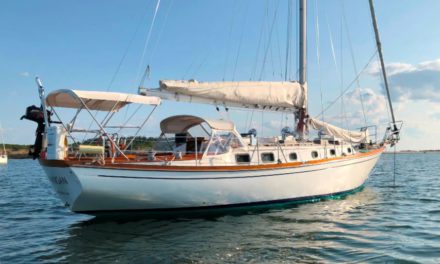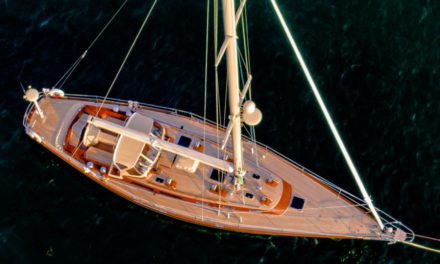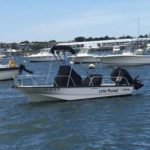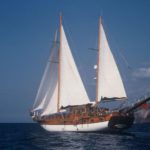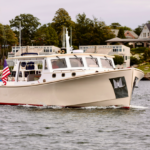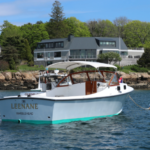“The 1990 Hunter Passage… has a full fiberglass hull from the waterline down, [with] our preferred layout, the full aft cabin, [and] good access into the engine bay”
Jibsea, Hunter 42′
Interview with the Captains — Steph & Travis
On Long Range Cruising
Can you tell us a little about yourself and how you came to live onboard your boat?
Steph is from Toronto and Travis is originally from Vancouver. We met when Travis moved to Toronto for work 5 years ago and we both had a passion to travel the world. We bought Jibsea in the Fall of 2019 with a plan to sail off and see as much of the world as we can by boat. We decided to move aboard right away after purchasing her, which meant living aboard during a cold Toronto winter! We figured it was the best way to learn the boat inside-out while saving some more money to embark on our big adventure.
Where have you sailed so far, and where are you heading next?
We have sailed from Toronto, Canada to the Bahamas. We went across Lake Ontario, into the Oswego and Eerie Canal systems, down the Hudson River and out to the Atlantic to make our way down to Florida via the ICW (hopping in and out of the ICW to avoid those notorious shallows – though we still ran aground, lol.) From Florida, we crossed the Gulf Stream to the Bahamas. We’re going to be heading through the Caribbean next but COVID-19 has altered our plans by the week or even by the day as travel restrictions continue to change.
Do you have a memorable story to share from your sailing adventures so far?
Each and every day has been memorable! There are honestly so many so we’ll just have share our first big memorable moment.
In light of the pandemic, travel by small pleasure vessels were deemed non-essential and therefore we didn’t think we’d be allowed to start our big adventure to sail south which required entering the US. When we made it across Lake Ontario, we didn’t know if this would be a weekend trip with Jibsea where we’d have to turn around back to our home port or whether we’d be making a complete 180 in our lives. It was a memorable moment for us when we woke up in the morning to our approval emails/notifications from the US Customs and Border Protection. It was that moment we were like “Okay, so this is really happening. We’re on this adventure now, sailing is our life and we’ll go where the wind takes us!”
Most under-rated piece of equipment for long-range cruising?
A good captain’s chair! No one likes a numb tush after long and choppy seas.
Do you have any other notable resources you use (apps, devices, etc)
Navionics on our tablet has been a god send! The depths have been fairly accurate while still displaying the recommended routes on Explorer Charts.
About Your Boat
Why did you choose to buy a Hunter?
We didn’t think we were going to buy a Hunter but when looking at listings, this boat had the ideal layout we had in mind, ticked almost every box we had in our long list and upon reading more about the Hunter 42 Passage, we felt this was a safe vessel for us to make our new floating home!
What other kinds of boats did you consider before buying this model (and how did they compare)?
No sailboat was off the table! We considered and looked at many different boats and models. We of course considered our budget, where the boat was located and how feasible it was for us to acquire it physically.
We wanted a layout with couches on both the port and starboard sides (so that sleeping/sitting on the couch would be possible despite either way we are heeled while underway). We wanted a U-shaped galley for safety so we could cook underway feeling a bit more enclosed. A full aft cabin was also important as we wanted to have a comfortable sleeping area without the need to duck down or feeling like we’re sleeping in a cave.
We considered an Elan 434 that had an ideal layout, great build quality and an overall nice looking boat! However, the one we had our eye on was out of our budget and located in Europe. We realized it wasn’t feasible for us at the time.
We considered a Hanse Christian but we realized we didn’t want a big full keeled boat for where we were planning on cruising primarily. That and some of them were out of our budget to get the adventure going in a short time. If and when we decide to cross the Atlantic, that may change!
Tartan was also on our list but many of them that we saw for sale required a lot of time and work, more than we had available to prepare for our sailing adventure in a short period of time. (We had a one year plan to leave from purchasing!)
From what we’ve read about the 1990 Hunter Passage, it has a Viking hull, a full fiberglass hull from the waterline down. It also had our preferred layout, the full aft cabin, good access into the engine bay, was within our budget and was literally located 3 mins from us!
How did you come to find/locate her before purchasing (and what’s the boat’s history if you know it)?
Travis scoured the internet looking for boats worldwide for hours every night. We came across the listing for this boat and it happened to be in the marina that was just down the street from where we lived. We believe the boat had two previous owners. The owners before us were refitting her to live off the grid. There were things already on board that weren’t as common to find on boats for sale near us in Lake Ontario such as wind, solar, big battery banks, a huge inverter, SSB radio and other things imperative to living on the hook!
Who first introduced you to sailing?
It was really just ourselves when we purchased the small 22’ for a couple summers to keep us entertained. We were actually looking to find kayaks to take in the Lake but saw an inexpensive sailboat for sale online so we decided to give that a go instead!
What boats have you previously owned?
It was mid winter and Travis randomly decided to buy a boat he saw online that came with a trailer. It was a 1976 Chrysler 22’ that we trailered up to Lake Huron a handful of times during the two summers we had her.
What are the features you like most about your boat?
The centre cockpit wasn’t our favourite at first – aesthetically speaking, but we think it’s the best feature because we actually feel safer being in the centre of the boat and up higher up especially in rough seas. Also, the centre cockpit allows us to have a full bedroom with a queen bed in the aft cabin where Travis doesn’t need to duck down when walking (he stands at 6’1”). The centre cockpit also means we have a full walk around along the deck which we quite like.
What features/improvements have you added or do you plan to add?
- Travis relocated the battery banks that were previously located in the engine bay and rerouted a lot of electrical, cleaned it all up so that the engine bay could be used as extra storage (his tool shed) and have the electrical look really simplistic and clean – far from what it looked like when we first bought her! The electrical was an absolute mess with inactive wires leading to no where when we traced them!
- We’ve also had the dodger and full enclosure redone the dodger so that we can see clearly out the windows. Travis sewed our sail sack on his very own to match the new canvas! We altered the stainless steel structure that supports the solar panels to give it a cleaner look. We mounted the solar panels above above the bimini and they extend past the cockpit, so that they also as a sunshade when sitting on the aft deck area.
- We removed the large dining table in the salon and use the ottoman as an extension to our couch. It makes for a very comfortable sitting/lay down area in the salon and opens up the space a lot.
- We removed the original decals and stripe on the hull and painted the grey stripe for a cleaner look.
- We installed a new mast, rigging and furler. We customized the furler to sit above the anchor locker instead of being situated inside the anchor locker for more accessibility.
- We also customized our dinghy davit system so that our dinghy swings/tilts off the transom as opposed to the common davit system involving a vertical raising/lowering
- We made new port holes using plexiglass and replaced all 11 aft port holes as they were initially so cracked that you could barely see through them
- We also installed a SeaWater Pro Watermaker once we arrived in Florida. We can’t imagine cruising without being able to make our own water. This has been one of the best additions to Jibsea!
How do you typically use your boat over the summer, and where do you go?
We can’t speak to many summers since we just got the boat not too long ago. The one summer that we had with Jibsea, we were living aboard in a marina so on weekends, we’d take her out on mini trips where we’d anchor in nearby bays in Lake Ontario.
What’s your homeport?
Our home port is Port Credit, Ontario, Canada
What is the biggest challenge you have in servicing your boat?
So far we haven’t found a big challenge in servicing the boat. We have great access to the engine bay from three points of entry. Located under our bed in the aft cabin, we have full access to the fuel tank, steering cables and linkage which allows for easy access and ample space for servicing.
Do you have any advice for those looking to buy a Hunter like yours?
We would look out for the usual things on any other boat you’re interested in purchasing.
-Hull
-Keel
-Keel bolts
-Rigging
-Grid structure
-Look up the mast with binoculars to make sure it looks as it should.
-Thru-Hulls, open & close them all.
-If the boat is out of the water, see if the rudder is solid and doesn’t shake – same goes for the propeller and shaft
-Ask about the V berth water tank. Apparently they are prone to leaking at the outlet. We no longer have a secondary water tank in the V berth because of that issue. We could go on but hope this helps!
What’s the story behind the boat’s name?
We chose this name because it has many meanings and is a play on words! “Jib” like the sail, and “sea” like… well, the sea. And phonetically Jibsea sounds like “gypsy” which is essentially how we’re living!
Check it Out
Click the gallery below for more photos and information about Jibsea!


